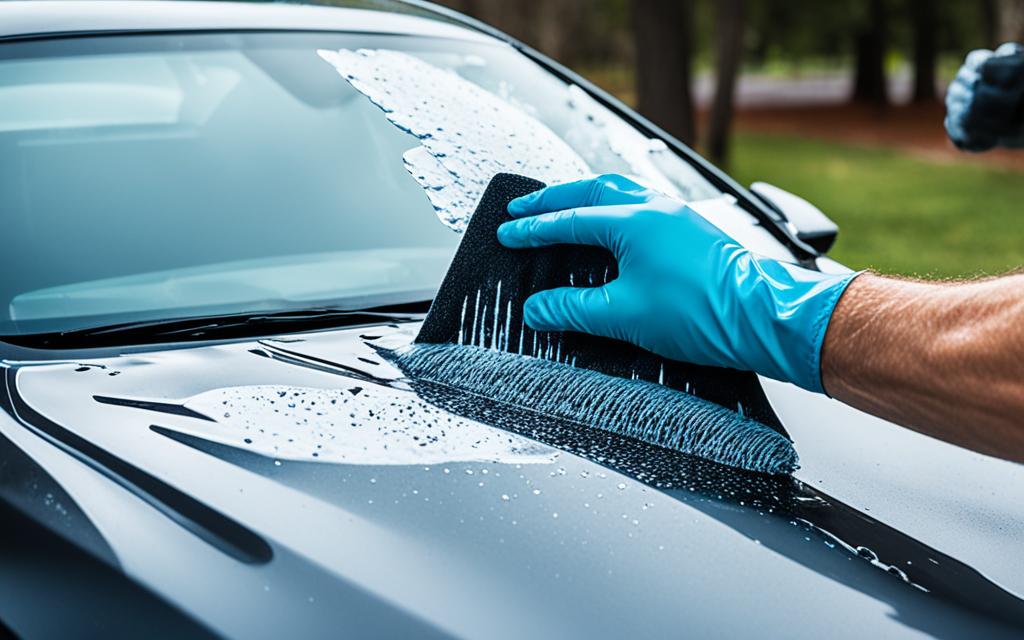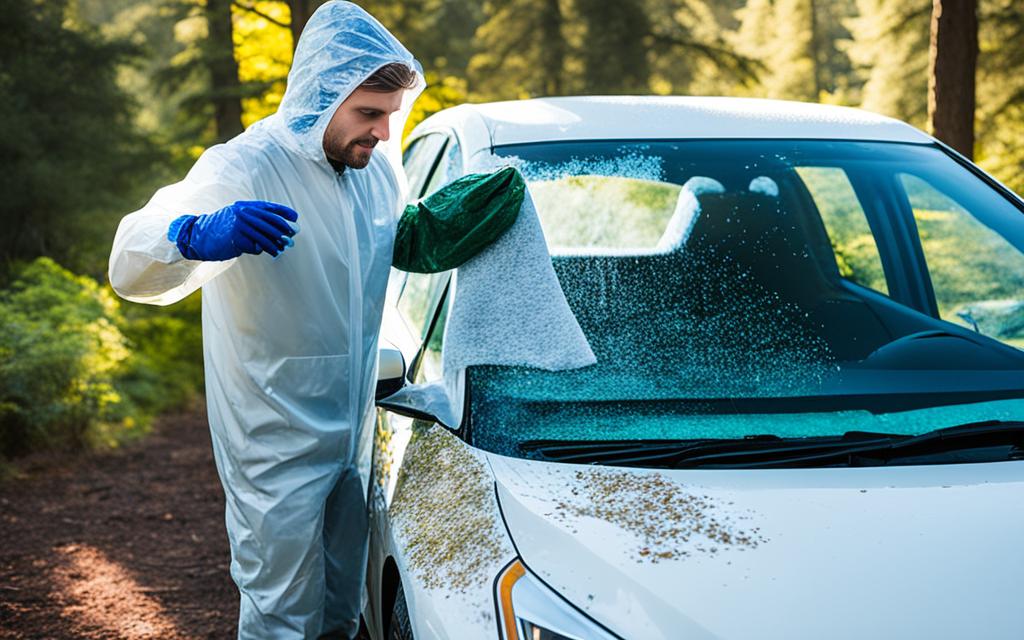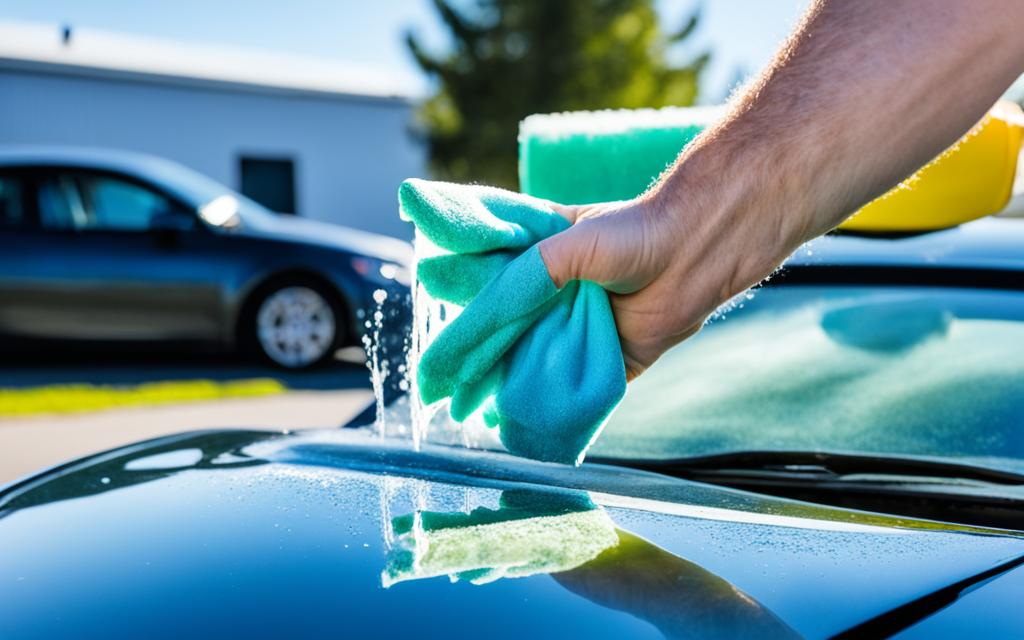Dealing with stubborn sap on your car can be a frustrating experience. Not only does it mar the appearance of your vehicle, but it can also damage the paintwork if not properly addressed. Fortunately, there are effective methods and techniques to safely remove sap from your car without leaving any lasting effects.
In this section, we will explore expert tips on how to get sap off your car and restore its pristine condition. Whether you prefer a DIY approach or seek professional assistance, we’ve got you covered with comprehensive advice on sap removal.
Key Takeaways:
- Removing sap from your car requires specific techniques to avoid damaging the paintwork.
- There are various DIY methods using household items that can effectively remove sap.
- If the sap is stubborn or extensive, it may be best to consult professional car detailing services.
- Preventive measures such as regular maintenance and protective coatings can help safeguard your car against future sap encounters.
- Avoid common mistakes and learn alternative sap removal techniques to achieve optimal results.
Understanding the Problem: Removing Tree Sap from Car Surfaces
Before we delve into the solutions, it’s important to understand the problem at hand—removing tree sap from car surfaces. Tree sap can be a stubborn and challenging substance to remove, often causing frustration among car owners. When left untreated, sap can damage the paintwork of your car, impacting its overall appearance and value.
Why is Removing Tree Sap Difficult?
Tree sap contains various sticky and adhesive compounds that make it adhere firmly to car surfaces. In addition, exposure to sunlight and heat causes the sap to harden and bond even more strongly over time. This can make removing sap a time-consuming and strenuous task.
Moreover, tree sap can be particularly problematic for car paint because it contains natural chemicals and resins that can penetrate the paint’s protective layer, causing staining and discoloration. It’s essential to address sap removal promptly to prevent any long-term damage to your car’s exterior.
Car Sap Cleaning Methods
Fortunately, there are several effective methods available to remove tree sap from car surfaces. Let’s explore some common and reliable cleaning techniques:
- Warm Soapy Water: Start by gently scrubbing the affected area with warm soapy water using a microfiber cloth or sponge. The soap helps to break down the sap’s adhesive properties, making it easier to remove.
- Rubbing Alcohol: Dampen a clean cloth with rubbing alcohol and gently rub the sap-covered area. The alcohol acts as a solvent, dissolving the sap and allowing it to be wiped away.
- Commercial Sap Removers: There are various commercially available sap removal products specifically designed for cars. These products often contain solvents or citrus-based formulas that effectively dissolve sap without harming the paint. Follow the instructions provided with the product for the best results.
- Clay Bar: A clay bar can be used to remove more stubborn sap residues. Apply a lubricant (often provided with the clay bar) to the surface and gently rub the clay bar over the sap. The clay’s sticky texture helps pull the sap off the paintwork.
Remember, always test any cleaning method on a small, inconspicuous area of your car before applying it to the entire sap-covered surface. This will help ensure that the method you choose is safe for your car’s paintwork.
“Removing tree sap from car surfaces can be a challenging task, but with the right techniques and products, it is possible to achieve a clean and spotless finish.” – Car Care Experts
Understanding the problem of removing tree sap from car surfaces is the first step towards successful removal. In the next section, we will explore tried and tested DIY techniques that can save you time and effort. Be sure to stay tuned!
DIY Sap Removal: Tried and Tested Techniques
If you prefer a do-it-yourself approach, this section provides step-by-step instructions on how to remove sap using household items and recommended sap removal products. Discover cost-effective solutions and tips for effective DIY sap removal.
Step 1: Prepare Your Materials
Before you begin, gather the following materials:
- Microfiber cloth
- Rubbing alcohol
- Warm water
- Dish soap
- Soft sponge
Step 2: Test for Compatibility
Prior to treating the sap, test a small, inconspicuous area of your car’s paintwork with the rubbing alcohol. This ensures that it doesn’t damage or discolor the paint. If the test area seems fine after a few minutes, you can proceed with confidence.
Step 3: Sap Removal Technique
Follow these steps to remove the stubborn sap:
- Soak the microfiber cloth in warm water and gently place it over the sap affected area. Leave it for a few minutes to soften the sap.
- Apply a small amount of dish soap to the sponge and gently scrub the sap in a circular motion. Be careful not to apply too much pressure, as it may damage the paint.
- If the sap doesn’t come off easily, dampen the microfiber cloth with rubbing alcohol and gently rub the sap. The alcohol helps dissolve the sap, making it easier to remove.
- Continue rubbing until all traces of sap are gone.
- Once the sap is removed, rinse the area with clean water to remove any residue.
- Dry the surface with a clean microfiber cloth.
Expert Tip: Remember to use gentle motions throughout the process to avoid scratching or damaging your car’s paintwork.
For tougher sap stains, you can also try using commercial sap removal products. Look for products specifically formulated for automotive use. These products are designed to effectively dissolve and remove sap without harming the paint. Follow the instructions on the product packaging for best results.
Now that you’ve learned effective DIY sap removal techniques, you can confidently tackle sap stains on your car. Be sure to follow the steps carefully and take your time to avoid any mishaps. With the right approach and the use of household items or recommended products, your car will be sap-free and looking its best in no time.
| DIY Sap Removal Tips | Sap Removal Products |
|---|---|
| Use warm water and dish soap to soften the sap. | Commercial sap removal products designed for automotive use. |
| Gently scrub the sap in a circular motion with a soft sponge. | Check product packaging for instructions on usage. |
| If needed, apply rubbing alcohol to dissolve and remove stubborn sap. | Ensure compatibility with your car’s paintwork. |
| Rinse the area with clean water to remove any residue. | |
| Dry the surface with a clean microfiber cloth. | |
| Follow all instructions carefully to avoid damage to your car. |
Professional Sap Removal: When to Call the Experts
Sometimes, no matter how hard you try, stubborn sap just won’t budge from your car’s surface. In such cases, it’s best to seek the expertise of car detailing services or professional sap removal technicians. They have the knowledge, experience, and specialized tools to safely and effectively remove sap without causing any damage to your car’s paintwork.
There are a few instances when calling the professionals for sap removal is highly recommended:
- Severe Sap Infestations: If your car is heavily covered in sap, attempting to remove it yourself may lead to scratches or paint damage. In such cases, it’s best to leave it to the experts who can handle the situation with care.
- Sensitive Surfaces: Some cars have delicate surfaces or custom paint jobs that require extra caution when removing sap. Professionals have the expertise to navigate these challenges and remove sap without compromising the integrity of the paintwork.
- Limited Time or Resources: Removing sap can be a time-consuming and labor-intensive process. If you don’t have the time, patience, or necessary tools to tackle the job yourself, calling the professionals is a convenient and efficient solution.
By opting for a professional sap removal service, you can enjoy the following benefits:
- Expertise: Professionals have in-depth knowledge of different types of sap and the most effective techniques for removal. They can quickly assess the situation and choose the best approach for your specific car and sap problem.
- Specialized Tools: Sap removal experts have access to specialized tools and equipment that are designed to safely and efficiently remove sap without causing any damage to your car’s paintwork.
- Protective Coating: After removing the sap, professionals often apply a protective coating to your car’s surface. This coating helps repel future sap encounters and keeps your car looking clean and shiny for longer periods.
When looking for a professional sap removal service, make sure to choose a reputable and experienced provider in your area. Read customer reviews and ask for recommendations to ensure you receive high-quality service and satisfactory results.
Testimonial from a Satisfied Customer:
“I had a stubborn sap stain on my car that I couldn’t remove no matter what I tried. I finally decided to call a professional sap removal service, and I’m so glad I did! They were able to remove the sap without any damage to my car’s paint, and now it looks as good as new!” – Sarah R.
Protecting Your Car’s Paintwork from Sap
When it comes to keeping your car’s paintwork pristine, prevention is key. Implementing the right strategies can help safeguard your vehicle against sap encounters, saving you time and effort in the long run. Here are some practical tips and techniques to protect your car’s paintwork:
1. Apply a Protective Coating
Consider applying a high-quality wax or sealant to create a barrier between your car’s paint and sap. These protective coatings can make it easier to remove sap and prevent it from adhering to the surface.
2. Regularly Clean and Maintain Your Car
Make a habit of regularly washing your car to remove any sap that may have fallen on it. Use a gentle car wash solution and a soft cloth or sponge to prevent scratching the paintwork. Additionally, ensure you dry your car thoroughly to avoid water spots or residue accumulation that may attract sap.
3. Park in Shaded Areas
Whenever possible, park your car in shaded areas to minimize exposure to sap. By avoiding direct sunlight, you can reduce the likelihood of sap dropping onto your vehicle’s surface.
4. Act Swiftly
If you notice sap on your car, take immediate action to remove it. The longer sap remains on the paintwork, the more it can penetrate and cause damage. Use the sap removal techniques mentioned in earlier sections to address the issue promptly.
5. Utilize Protective Covers
Consider using car covers or protective tarps to shield your vehicle when parking under trees. This extra layer can prevent sap from directly landing on your car’s paint and make cleaning easier.
| Pros | Cons |
|---|---|
| Effective in preventing sap from adhering to paint | Requires regular maintenance and reapplication |
| Provides additional protection against other environmental elements | Can be costly, especially if opting for professional coatings |
| Reduces the need for intensive sap removal | May alter the appearance of the paint surface |
Remember, prevention is the best defense against sap damage. By implementing these tips and techniques, you can protect your car’s paintwork and enjoy a sap-free driving experience.

Common Mistakes to Avoid when Removing Sap
Removing sap from your car can be a tricky process, but with the right knowledge and techniques, you can keep your car looking spotless. However, it’s important to be aware of common mistakes that can lead to potential damage and instead focus on effective sap removal tips. Here are some common mistakes to avoid when removing sap from your car:
1. Using Harsh Chemicals
Avoid using harsh chemicals or solvents to remove sap from your car’s surface. These harsh substances can damage the paintwork and cause discoloration. Instead, opt for gentler alternatives such as rubbing alcohol or warm soapy water.
2. Scrubbing Too Hard
While it may be tempting to scrub vigorously to remove stubborn sap, avoid excessive scrubbing. Scrubbing too hard can leave scratches on your car’s paint. Instead, use a soft cloth or sponge and apply gentle pressure when trying to remove the sap.
3. Using Abrasive Materials
Avoid using abrasive materials such as steel wool or rough brushes to remove sap. These materials can also cause scratches and damage to your car’s paint. Instead, use soft microfiber cloths or specialized sap removal tools for a safer and more effective removal process.
4. Ignoring the Need for Lubrication
In some cases, sap can be difficult to remove without proper lubrication. Avoid scrubbing or scraping the sap directly without first applying a suitable lubricant. Consider using products such as vegetable oil or a dedicated sap removal spray to help loosen the sap before gently wiping it away.
By avoiding these common mistakes, you can ensure a successful sap removal process without causing any damage to your car’s paintwork. Remember to always exercise caution and patience when removing sap from your car, and seek professional help if needed.
In the next section, we will explore alternative methods for sap removal that you may not have considered before. Stay tuned!
Alternative Methods for Sap Removal
When it comes to removing sap from your car surfaces, not all methods are created equal. While some techniques may be widely known and effective, there are also alternative methods and products that can help you achieve a sap-free car. These lesser-known approaches may be just what you need to tackle stubborn sap stains. Explore the following alternatives and find the best way to remove sap from your car paint:
1. Rubbing Alcohol
One alternative method for sap removal is to use rubbing alcohol. Dampen a cloth with rubbing alcohol and gently rub the affected area in circular motions. The alcohol helps break down the sticky sap, making it easier to remove. Remember to test the rubbing alcohol on a small, inconspicuous area of your car’s paint first to ensure it does not cause any damage.
2. WD-40
WD-40 is not only handy for lubrication purposes but can also be used as an effective sap remover. Spray a small amount of WD-40 onto the sap-covered surface, let it sit for a few minutes, and then wipe it away with a clean cloth. The WD-40 helps dissolve the sticky sap, allowing for easy removal without harming your car’s paintwork.
3. Peanut Butter
Believe it or not, peanut butter can be a surprising ally in sap removal. Apply a generous amount of creamy peanut butter onto the sap, let it sit for a few minutes, and then gently scrub the area with a soft cloth or sponge. The natural oils in peanut butter help break down the sap, making it easier to wipe away. Remember to wash the area thoroughly with soap and water afterward to remove any residue.
Expert Tip: Always spot test any alternative method or product on an inconspicuous area of your car’s paintwork before applying it to the sap stains. This will help you ensure that the chosen method does not cause any damage or discoloration.
These alternative methods can be effective in removing sap from your car, but it’s essential to exercise caution and avoid scrubbing too forcefully, as this can damage the paint. If you are unsure or hesitant about trying these methods yourself, it’s best to consult a professional sap removal service or car detailing expert.
Now that you are aware of these alternative sap removal methods, you can confidently tackle sap stains and keep your car looking pristine. However, prevention is always better than cure. In the next section, we will explore tips for protecting your car’s paintwork from sap encounters to minimize the need for removal in the first place.

Maintaining a Sap-Free Car: Tips for Ongoing Care
Once you’ve successfully removed sap from your car, it’s essential to maintain a sap-free surface. By following these practical tips and incorporating ongoing care routines, you can ensure that your car stays clean and protected from potential sap encounters. Let’s dive in!
1. Regular washing
One of the best ways to keep sap at bay is to regularly wash your car. Use a high-quality car wash solution specifically designed to remove dirt, grime, and sap residue from the surface. Be sure to pay extra attention to areas where sap is most likely to accumulate, such as the roof, hood, and trunk.
2. Immediate cleaning
If you notice fresh sap on your car, it’s crucial to take immediate action. Use a mild soap or sap remover and a soft cloth to gently clean the affected area. Avoid scrubbing vigorously, as this can damage the paint. Remember to rinse thoroughly with clean water afterward.
3. Protective wax
Apply a layer of protective wax to your car’s paintwork to create a barrier against sap and other contaminants. This wax coating serves as an additional shield, making it easier to remove sap in the future. Choose a high-quality wax product and follow the manufacturer’s instructions for best results.
4. Parking in shaded areas
Sap is typically found on tree branches, so parking your car in shaded areas can help minimize the chances of sap landing on your vehicle. Select parking spots away from trees or use car covers to provide an extra layer of protection.
5. Regular inspection
Make it a habit to regularly inspect your car’s surfaces for any signs of sap or other contaminants. Promptly removing any sap you find can prevent it from hardening and causing further damage to your car’s paintwork.
6. Professional detailing
Consider scheduling regular professional car detailing sessions to maintain your car’s overall cleanliness and protect it from sap and other elements. Professional detailers have the expertise and specialized products to safely remove sap and restore your car’s shine.
Expert Tip: Avoid using harsh chemicals or solvents when cleaning sap from your car, as they can strip away the protective layer of wax and damage the paintwork. Stick to gentle cleaning agents and techniques to ensure the longevity of your car’s exterior.
By following these tips for ongoing care, you can keep your car free from sap and maintain its pristine appearance. Remember to wash regularly, clean sap immediately, apply protective wax, park in shaded areas, inspect regularly, and consider professional detailing for optimal results.
Now that you have a comprehensive understanding of sap removal and maintenance, let’s conclude our journey through the world of car sap care.
Conclusion
In conclusion, removing sap from your car doesn’t have to be a daunting task. With the right techniques and products, you can easily achieve a spotless car surface. Whether you choose to tackle sap removal yourself or seek professional help, maintaining a sap-free car is possible.
By following the expert tips shared in this article, you have learned effective methods to get rid of stubborn sap without causing damage to your car’s paintwork. The DIY sap removal techniques provide step-by-step instructions using household items or recommended sap removal products.
If DIY is not your preference or the sap is particularly stubborn, you can always rely on professional sap removal services. They have the experience and expertise to safely remove sap from your car, ensuring it is restored to its former shine.
FAQ
How do I remove sap from my car?
To remove sap from your car, you can start by applying a generous amount of rubbing alcohol onto a clean cloth and gently rubbing the affected area. Alternatively, you can use WD-40 or a mixture of baking soda and water. Be sure to rinse the surface thoroughly afterward to prevent any damage to your car’s paintwork.
What are some effective sap removal tips?
Some effective sap removal tips include using a clay bar for stubborn sap, using warm soapy water and a soft brush, or using a commercial sap removal product. It’s important to test any product or method on a small, inconspicuous area of your car first to ensure it doesn’t cause any damage.
Can I remove sap from my car myself?
Yes, you can remove sap from your car yourself. There are several DIY methods and products available that can effectively remove sap without causing damage to your car’s paintwork. However, it’s important to follow the instructions carefully and test any method or product on a small area first.
When should I seek professional sap removal services?
If you have tried various DIY methods and still cannot remove the sap from your car, or if the sap has caused significant damage to your car’s paintwork, it may be best to seek professional sap removal services. Professional car detailing services have the expertise and specialized tools to safely remove sap without causing further damage.
How can I prevent sap from damaging my car’s paintwork?
To prevent sap from damaging your car’s paintwork, it’s advised to park your car in a covered area or under a tree that doesn’t produce sap. Regularly waxing your car can also create a barrier against sap, making it easier to clean off. Additionally, promptly remove any sap that lands on your car to prevent it from hardening and causing damage.
What are common mistakes to avoid when removing sap?
Common mistakes to avoid when removing sap from your car include using abrasive materials that can scratch the paint, leaving the sap to dry and harden, and applying excessive force while trying to remove the sap. It’s important to be gentle and patient during the sap removal process to avoid causing any damage.
Are there alternative methods for sap removal?
Yes, there are alternative methods for sap removal. Some alternative techniques include using olive oil, peanut butter, or even mayonnaise. These substances can help break down the sap, making it easier to remove. However, it’s important to test these methods on a small area first to ensure they don’t cause any adverse effects on your car’s paintwork.
How can I maintain a sap-free car?
To maintain a sap-free car, it’s important to regularly wash and wax your car, especially in areas prone to sap. If sap does land on your car, remove it promptly using one of the recommended sap removal methods. Additionally, parking your car away from trees that produce sap can help minimize the risk of sap landing on your car.








